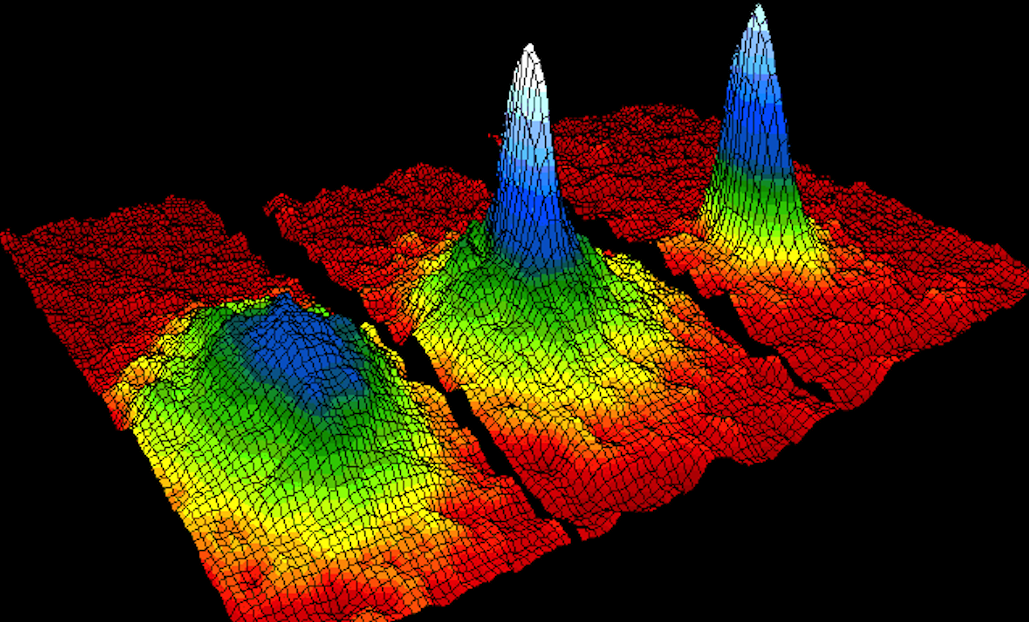It’s been created on the International Space Station the fifth state of matter, it isn’t gaseous, liquid, solid or plasma, but it’s something different. What’s the point of the 5° state of the matter? According to the scientists of the NASA it will solve many of the riddles of the universe, like the ones about the dark energy.
The previous four state of matter
We studied them at school, trite. But weren’t them three? Liquid, solid and gaseous (or better, aeriform), which passage, between one and another, is ruled by the temperature with which we heat or we cool the matter.
There is though a four state: the plasma. The plasma is ionized gas, made by electrons and iones, with zero electric charge.
The fourth state of the matter was discovered by Sir William Crookes, in the 1879, but only the studies of Irving Langmuir, in the 1928, gave it the name of plasma.
The plasma is less known compared with the other three states until now known because on the Earth its presence is almost nothing. Only the lightning and the northern lights are under the shape of plasma.

Another example of matter in the plasma state is the ionized gas that forms on the heat shield of the space crafts when they come back inside the terrestrial atmosphere.
In the space, instead, the fourth state is dominant, the 99% of the known matter, infact, is under the shape of plasma. We have to say, though, that only the 5% of the universe is composed by known matter. The remaining 95% is dark matter. Are under the shape of plasma the stars, like our sun or the nebulas.
The fifth state of the matter
We were able to create the fifth state of matter! We did it in the space, preciselly onboard of the ISS. The 5° state of the matter takes the name of condensate of Bose – Einstein and it was created by the scientists of the NASA.
The study was then published on Nature and the scientifical world is on high for it. That remaining 95% of the universe about which we were talking before, the dark matter, might be under the shape of condensate of Bose – Einstein, or at least its discovery might help us to solve many of the universe’s riddles.
What is the 5° state of matter?
The fifth state of matter, called Bec (condensate of Bose – Einstein), takes the name from who as first assumed it: Albert Einstein and Satyendra Nath Bose. To find out or to create the 5° state of matter is almost impossible. It can be obtained when the bosons (particles with the same number of protons and electrons) are cooled almost to the absolute zero.

To steps away from the absolute zero the bosons don’t act anymore as separate entities, but like only one entity, which is in very particular conditions. They are infact in the middle between the macro and micro world. The first one which is ruled by forces like the gravity, the second one by the quantum mechanics.
But even once reached the fifth state of matter, it is highly unstable. It can interact with the external world, because it will heat it over the condensation limit.
For this reason it is impossible to create it on the Earth, where everything, first of all the gravity, interact with it.
The creation of the condensate Bose – Einstein
The fifth state of matter was created inside the Cold Atom Laboratory, of the Jet Propulsion Lab, the lab onboard of the ISS which is able to get very close to the absolute zero.
The researchers of the NASA used the rubidium, to create a condensate Bose – Einstein more stable compared with the previous attempts. Infact, it isn’t the first time that the researchers tried to create the condensate of Bose – Einstein. The first time were the researchers of the Leibniz University, in Germany.
But this time the Bec lasted for more than a second, while in the previous experiment it lasted just for a bunch of milliseconds.
The study of the fifth state of matter opens interesting scenario for the resolution of the mysterys of the universe: “The applications go from the experiments about the general relativity, to the researches of the dark energy and of the gravitational wavese, passing by the study of the minerals on the Moon and on the other space bodies”.
This post is also available in:

